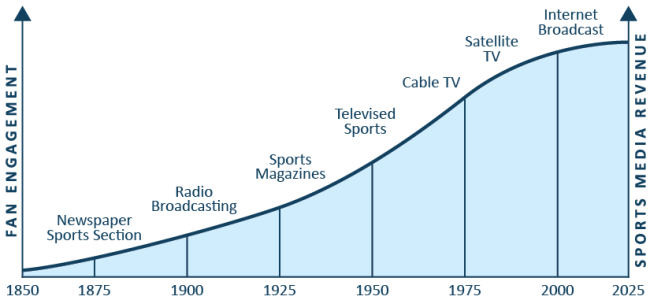Preview table of contents and sample page

About This Report
This report captures the many ways fans consume sport from attending, watching, betting on, playing fantasy sports to playing sports video games. In this report, Fan Engagement is divided into three core areas: Sports Events, Sports Entertainment and Sports Media. Each section provides in-depth analysis of conditions and factors that have impacted the financial performance of the segments comprising the core areas, an examination of the post COVID recovery of each, with projections of revenue growth over the next several years. Woven into the analysis area number of videos and exhibits highlighting new trends in each section of the report.
SPORTS EVENTS are at the heart of the business of sport. This section of the report focuses on the four-core revenue generating sources of live sports events: Gate Revenues, Media Rights, Sponsorships and Merchandise Sales. The annual revenues produced by each are analyzed over a 6-year period to assess post-COVID rates of recovery. Also featured is a section examining the new generation of “Billion $” sports venues loaded with features to enhance the fan experience, and the emerging prominence of arenas and stadiums as the centerpiece of a wave of new sports and entertainment districts (SEDs).
SPORTS ENTERTAINMENT includes the many ways fan engage in sport through mostly virtual experiences, including betting on sports, viewing esports competitions, joining a fantasy sports league, playing sports video games, buying sports collectibles and rooting on the home team with friends at a local sports bar. In 2023, worldwide spending across all six of these core areas totaled $375 billion, with the U.S. accounting for $154 billion (41%) of the total. Several of these sport engagement options are among the most popular and fastest growing across all dimensions of sport. Leading the way is sports gambling. Betting on sports is the fastest growing segment in the U.S., followed closely by the sports collectibles market, projected to grow to $200 billion by 2032. The report examines the conditions and factors that that have influenced the growth of each of the six sport entertainment segments.
SPORTS MEDIA: In 2023, global spending on sports media reached $150.5 billion. The U.S. accounted for 44%, topping $67 billion. This section of the report examines changing sports media landscape, focusing on three interconnected factors: 1) the popularity of live sports events, 2) the massive loss of cable television subscribers and programming and 3) the rapid growth of the internet and emergence of new streaming technologies. By 2025, 73% of smartphone users globally are projected to access the internet exclusively on their phones. While a majority of Americans view all, or most, of live sports on traditional TV, most of the world – and a growing number of North Americans – watch sports exclusively online via streaming platforms, using a variety of digital devices. As more viewers have shifted from linear to internet options, prominent sports properties and corporations have recently invested billions to attract their share of the rising number online viewers to their streaming platforms. Disney’s ESPN, Amazon, Google and Paramount have purchased the rights to stream popular live sporting events (NFL, MLS, MLB) to attract numerous new subscribers and advertising dollars. These Direct-to-consumer platforms allow leagues and teams to reach new, younger audiences.

Sports Industry Report
Contents
CONTENTS
Sample Page 1
Fan Engagement

Where would the sports industry be without fans?
Fan engagement is the driving force of the sports industry with 2023 global revenues of $750.3 billion. This resulted entirely from fans who paid to go to sports events, watched media broadcasts, bought team and player merchandise, bet on events, played fantasy sports, and purchased sports video games.
Fans’ enthusiasm and loyalty to the teams and players they support are at the heart of the sports industry. Indeed, the term “fan” is derived from the word “fanatic,” a person displaying excessive enthusiasm and intense devotion. Fans often identify with the teams they support (Figure I), and after “big wins,” avid fans often wear their team’s apparel, buy more team merchandise, and use phrases like “we won” when describing the victory. Following disappointing losses, fans tend to distance themselves from their team by not wearing apparel and using language like “they lost,” omitting reference to the team by name.
FIGURE I
Fan Passion Provides Pride, Belonging & Self-Esteem
Copyright 2025 The Business of Sports
01
Sample Page 4

The Heart of Sports Business
The heart of the sports industry is the hundreds of thousands of organized games, matches, and races that occur around the globe each year. Fueled by competition, drama, and pageantry, passionate fans in the hundreds of millions attend and watch sports events played in ever more lavish and expensive stadiums and arenas.
Gate receipts are just one component of the revenues derived from sports events. Money spent by fans to park and to purchase food and beverages adds to event revenue, as does the sale of media rights. Media companies pay teams and leagues to broadcast their events on TV, radio, or the Internet. (Figure 1.1).
FIGURE 1.1
Sports Events Segments

Sponsorships – money a corporation pays to a team to advertise and promote its brand at events – are another important source of sports event revenue. Sponsorships can range from placing brand names or logos on player jerseys to investing millions in placing a corporation’s name on a stadium or arena.
The sale of team or league merchandise at events, in retail stores, or online also provides revenue for teams, leagues, and sometimes athletes.
Finally, the billions invested in constructing a new generation of “state of the art” stadiums
and arenas full of expensive luxury seating options and amenities has produced abundant income streams for team owners and event operators.
04
Copyright 2025 The Business of Sports
Sample Page 38
Sports Entertainment

Extending Sports Enjoyment
The Best-Howard Model (Figure 2.1) examines how fans engage the sports industry through mostly virtual experiences through its Sports Entertainment core area. Betting online, participating in or viewing esports competitions, joining a fantasy sports league, and playing sports video games with friends can all be accomplished on various electronic devices, allowing easy and around-the-clock fulfillment.
Sports fans worldwide spent $38 billion in 2023 on sports memorabilia, from trading cards to game-used items like balls and jerseys. The value of cards and iconic sports merchandise has appreciated so rapidly over the past decade that some collectors view sports memorabilia as investment-grade assets. Spurred by the rapid expansion of online platforms, the sports trading market is projected to reach over 100 million collectors globally within the next three to five years.
The Best-Howard Model also recognizes an increasingly popular sports engagement dimension, social dining experiences in sports-themed environments. Restaurant Business magazine recently recognized sports bars as a standalone industry category. In 2023, total sports bar sales reached $11.7 billion in the United States alone.
This chapter is devoted to providing an in-depth examination of the performance of each of the six segments, detailing spending trends over the past decade and projections for future growth.
Sports Entertainment Segments

38
Copyright 2025 The Business of Sports
Sample Page 88
Sports Media

Extending Fan Engagement
Many sports fans around the globe will never attend a live event to watch their favorite teams or players in person. For them, the only way to experience a sports event is by watching it on a television, computer or mobile device screen or listening to it on the radio. In many countries, traditional television is the overwhelming viewing option for watching live sports. A global survey of fan viewing behavior found two-thirds or more of respondents in Brazil (78%), Argentina (75%) France (74%), Indonesia (73%), Spain (68%), Italy (67%), China (66%) and India (66%) watched their favorite teams play on television (1). While TV remains the predominant viewing option in many countries, the rapid growth of online options allows an increasing share of fans to follow their favorite teams on mobile devices. A recent study in the United Kingdom found 59% of British sports fans prefer watching live sports exclusively on streaming platforms.
FIGURE 3.1
Evolution of Sports Media and Fan Engagement

88
Copyright 2025 The Business of Sports

